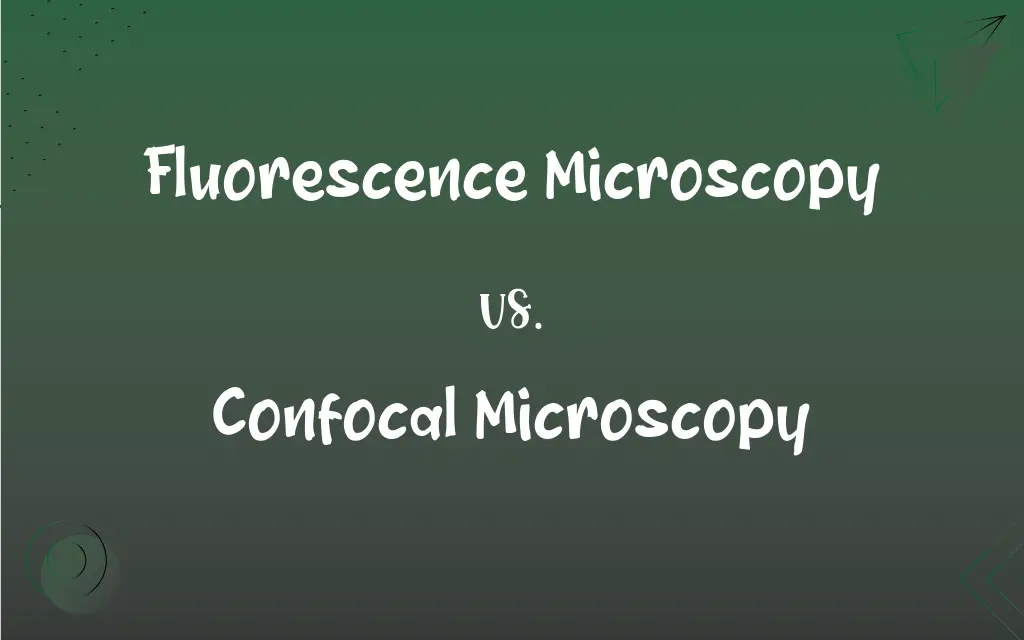Fluorescence Microscopy vs. Confocal Microscopy: What's the Difference?
Edited by Aimie Carlson || By Janet White || Published on September 17, 2024
Fluorescence microscopy visualizes specimens using fluorescent light, while confocal microscopy adds spatial filtering for sharper, 3D images.

Key Differences
Fluorescence microscopy is a technique that illuminates samples with a specific light wavelength, causing them to emit a longer wavelength light, thus highlighting certain structures. Confocal microscopy, on the other hand, not only uses fluorescence to visualize samples but also incorporates a spatial pinhole to eliminate out-of-focus light, providing clearer and more detailed images, particularly useful for thicker specimens.
In fluorescence microscopy, the entire sample is uniformly illuminated, which can lead to background fluorescence and a decrease in image contrast. Confocal microscopy significantly improves upon this by using point illumination and a spatial filter, which ensures that only light from the focal plane is detected, greatly enhancing image clarity and contrast.
Fluorescence microscopy is widely used for its simplicity and effectiveness in highlighting specific components of a specimen, but it may suffer from issues like photobleaching and a lack of depth information. Confocal microscopy addresses these issues by offering controlled illumination and the ability to reconstruct three-dimensional structures from serial optical sections, making it a powerful tool for detailed structural analysis of cells and tissues.
Fluorescence microscopy is suitable for observing live cells and dynamic processes due to its relatively low light intensity, it cannot provide the same level of detail in z-axis resolution as confocal microscopy. Confocal microscopy, with its laser-scanning capability, allows for precise control over depth, making it ideal for studying the intricate architecture of specimens.
Fluorescence microscopy offers a broader field of view, making it preferable for observing larger areas or more samples simultaneously. In contrast, confocal microscopy, with its pinhole aperture, provides a narrower field of view but with superior resolution and the ability to collect serial optical sections, essential for detailed 3D reconstruction and analysis.
ADVERTISEMENT
Comparison Chart
Illumination
Uniform across the sample
Point illumination with spatial filtering
Image Clarity
Lower due to background fluorescence
Higher due to elimination of out-of-focus light
Depth Information
Limited depth information
Detailed depth information through optical sectioning
Suitability for Live Cells
Suitable due to lower light intensity
Less suitable due to higher intensity and potential damage
Field of View
Broader, good for larger samples
Narrower, focused on detailed, localized observation
ADVERTISEMENT
Fluorescence Microscopy and Confocal Microscopy Definitions
Fluorescence Microscopy
A microscopy technique that visualizes specimens by emitting light after excitation.
Fluorescence microscopy revealed the intricate patterns of cell membranes.
Confocal Microscopy
A microscopy technique that enhances image clarity using spatial filtering and point illumination.
Confocal microscopy provided a three-dimensional reconstruction of the tissue architecture.
Fluorescence Microscopy
A visualization method that exploits the properties of fluorescent dyes to study biological samples.
The lab used fluorescence microscopy to track the movement of tagged molecules within cells.
Confocal Microscopy
A method that uses a laser to scan samples, providing high-resolution images.
The researchers utilized confocal microscopy to examine the interactions between cells in detail.
Fluorescence Microscopy
A method utilizing fluorescent light to highlight specific structures within samples.
Scientists used fluorescence microscopy to observe the distribution of proteins in the cell.
Confocal Microscopy
A method offering detailed three-dimensional imaging by sequentially scanning different focal planes.
Confocal microscopy enabled the detailed study of tissue morphology and function.
Fluorescence Microscopy
A technique where specimens are illuminated with a certain wavelength of light to emit fluorescence.
Fluorescence microscopy allowed for the detailed visualization of neuronal structures.
Confocal Microscopy
A technique for obtaining sharp images and optical sections from various depths within a sample.
Confocal microscopy was instrumental in visualizing the layers of the retina.
Fluorescence Microscopy
A microscopy approach using fluorescence to illuminate and observe microscopic entities.
Fluorescence microscopy was crucial in identifying the subcellular localization of the receptor.
Confocal Microscopy
A microscopy approach that reduces background noise and increases contrast by using a pinhole.
Scientists relied on confocal microscopy for precise imaging of synaptic connections.
FAQs
Can fluorescence microscopy provide three-dimensional images?
It's not typically used for 3D imaging due to its lack of optical sectioning capabilities, unlike confocal microscopy.
What is fluorescence microscopy?
It's a technique that uses fluorescent light to visualize and study properties of organic or inorganic substances.
Are there any limitations to using fluorescence microscopy?
Limitations include photobleaching, lack of depth information, and potential background fluorescence.
Can fluorescence microscopy be used to study the interaction between different cell components?
Yes, it can highlight specific structures or molecules within cells when those components are tagged with fluorescent markers.
What makes confocal microscopy unique in terms of image clarity?
Its use of a spatial filter (pinhole) to block out-of-focus light greatly enhances image clarity and resolution.
Is confocal microscopy better for live cell imaging than fluorescence microscopy?
Fluorescence microscopy is generally better for live cell imaging due to its lower light intensity and faster acquisition times.
How does confocal microscopy differ from fluorescence microscopy?
Confocal microscopy adds spatial filtering and point illumination to provide sharper, more detailed three-dimensional images.
How does confocal microscopy provide depth information?
It optically slices through a sample by focusing at different depths, allowing for the reconstruction of 3D images.
Why is confocal microscopy considered to be more detailed?
Its ability to eliminate out-of-focus light and precisely control depth leads to higher resolution and more detailed images.
What is a common use of fluorescence microscopy in research?
It's widely used to visualize the distribution and movements of specific proteins or other molecules within cells.
Is it possible to use both techniques together?
Yes, many modern microscopes integrate both functionalities to leverage the advantages of each method.
What are the key applications of confocal microscopy?
It's used extensively in fields requiring detailed structural analysis, such as neurobiology, cell biology, and tissue engineering.
What role do fluorescent dyes play in fluorescence microscopy?
They bind to specific cell components and emit light upon excitation, allowing those components to be visualized.
How do photobleaching effects compare between the two methods?
Photobleaching can be a more significant issue in fluorescence microscopy due to the continuous illumination of the entire specimen, whereas confocal microscopy's localized illumination can mitigate this effect.
Can confocal microscopy visualize live processes within cells?
Yes, but it might be less suitable than fluorescence microscopy for long-term live-cell imaging due to potential phototoxicity.
Can confocal microscopy be used on non-biological samples?
Yes, it's also used in materials science and industrial applications to examine surface topography and composition.
What is a primary advantage of using fluorescence microscopy?
Its simplicity and effectiveness in highlighting specific components of a specimen make it a versatile tool in many applications.
Why might confocal microscopy be chosen over fluorescence microscopy for certain studies?
For studies requiring detailed 3D reconstruction or high-resolution images of thick specimens, confocal microscopy is more suitable.
How does the field of view compare between fluorescence and confocal microscopy?
Fluorescence microscopy typically offers a broader field of view, while confocal microscopy provides a more focused, detailed view.
How do the illumination methods differ between the two types of microscopy?
Fluorescence microscopy uses uniform illumination across the sample, while confocal microscopy uses point illumination.
About Author
Written by
Janet WhiteJanet White has been an esteemed writer and blogger for Difference Wiki. Holding a Master's degree in Science and Medical Journalism from the prestigious Boston University, she has consistently demonstrated her expertise and passion for her field. When she's not immersed in her work, Janet relishes her time exercising, delving into a good book, and cherishing moments with friends and family.
Edited by
Aimie CarlsonAimie Carlson, holding a master's degree in English literature, is a fervent English language enthusiast. She lends her writing talents to Difference Wiki, a prominent website that specializes in comparisons, offering readers insightful analyses that both captivate and inform.






































































